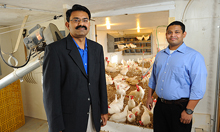Using phytogenics in the war against Salmonella

Salmonella is the enemy and University of Connecticut researchers at the College of Agriculture and Natural Resources may have discovered a way to defeat it – one molecule at a time.
This gram-negative bacterium causes annually over a million cases of salmonellosis in the United States, a potentially fatal disease in the elderly, the very young, and those with suppressed immune systems.
Small but tough and commonly found in poultry and dairy products, salmonella can survive for relatively long periods of time in the environment – from weeks to months – and some serotypes have emerged that are resistant to many available antibiotics.
But, animal science professor Kumar Venkitanarayanan and his post-doctoral fellow Anup Kollanoor Johny, have determined that natural food grade molecules found in such familiar sources as cinnamon, cloves, oregano, and coconut oil seem to have the ability to shut down the genes that enable the bacterium to colonize in the caeca of chickens.
Turn down genes
Venkitanarayanan explains the problem this way: “The bacterium colonizes the intestinal tract of chickens. It’s excreted in droppings and contaminates the meat and the eggs. Within the bird, Salmonella travels from the intestine to the ovaries and contaminates the yolk even before an egg shell is formed. So an intact egg can have Salmonella in the yolk.”
During his doctoral studies with Venkitanarayanan, Kollanoor Johny hypothesized that the molecules contained in certain foods could help ‘turn down’ the genes in the bacteria that prompt them to colonize and invade chickens’ intestinal cells before they are spread to internal organs. Research has proven him correct.
According to Mike Darre, professor of animal science in the College of Agriculture and Natural Resources and extension poultry specialist, “it’s a tough thing to get rid of [Salmonella] completely. The idea of using natural food molecules in feed and in washes, at a relatively low cost to the farmer … and without the need for antibiotics … has great benefit.”
Multiple functionality
Kollanoor Johny says these natural molecules have multiple functionality. “They are derived from nature,” he says. “At the same time they are killing Salmonella, we also believe that they have potential human health benefits because of the various functional capabilities, including everything from acting as antioxidants to lowering blood pressure and aiding in cardiovascular health.
The next step, according to Kollanoor Johny, is to make sure that adding food grade molecules to poultry feed is not harmful to the birds:
“Our initial findings show that these molecules are completely safe in chickens, but we need to do more studies to make sure the meat and eggs are still palatable. We don’t want eggs to be cinnamon flavoured!”
Photo: Kumar Venkitanarayanan, professor of animal science, left, and Anup Kollanoor Johny, a postdoctoral fellow in animal science, with chickens at the Poultry Unit. Credit: Peter Morenus/UConn Photo











